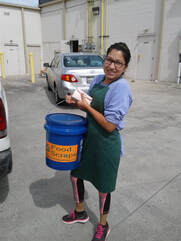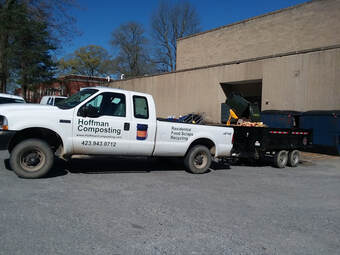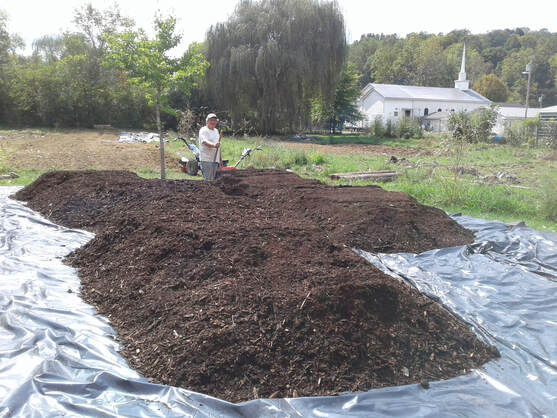|
Read below or click this link to download this guide for free.
|
| ||||||
Before you take the plunge and spend a lot of money to start your compost business, you should do some serious market research. Keeping in mind the fact that your business has two revenue streams – inbound and outbound, you’ll need to research the markets for both. In this post, you’ll learn what kinds of information you must gather, where to look for it, and what kinds of numbers to expect.

Inbound Revenue Market Research
Your research into your inbound revenue market will help you answer some key questions:
Your research will cover each of the seven types of food scraps generators: food product manufacturers, institutions, households, full service restaurants, grocery stores, coffee shops and juice bars, and other businesses. For each of these types, you’ll need to answer the following questions:
Where and how do you get this information?
You have several sources to explore – publicly available waste studies, your local solid waste department, the waste industry, individual businesses, and individual residents. Start with the general information first. That way, you’ll have a better idea of what questions to ask, and you’ll establish your seriousness.
PUBLICLY AVAILABLE STUDIES
Start with general data like the EPA and waste audits. In addition to giving you an overall picture of the waste stream situation in our society, you’ll start to get an idea for what kinds of numbers to expect on average.
SOLID WASTE DEPARTMENT
Next, approach your community’s solid waste department. In all likelihood, they will not want to perform separate collection of food scraps, no matter how low your tipping fees may be. However, they may be able to share some valuable information with you. They might tell you how big the dumpsters a given business has or rents. They might also tell you how many times that dumpster is emptied each week. From those two pieces of information, you can calculate how much the business is currently paying for waste collection. They may even have estimates of how much weight a given business throws out each week. Even if the solid waste department is unable or unwilling to share such detailed information with you, they should at least be able to give you valuable aggregate information, such as:
THE WASTE INDUSTRY
The huge waste companies that dominate the industry – Waste Management, Waste Connections, and Republic – are involved in various sustainability efforts. They are more approachable about information than you might expect. They may even be open to some sort of collaboration. Another company, Northstar, is worth mentioning. Northstar helps businesses recycle their waste. If you manage to get a composting facility up and running, they will eventually contact you with an offer. The quantities they deal with are huge.
INDIVIDUAL BUSINESSES
The owners and managers of private businesses are under no obligation to share any information with you at all. Some won’t want to spend time talking with you. Others are concerned with this issue and will be happy to and are very forthcoming with detailed information. Whenever you are talking with an interested owner or manager, try to get them to go ahead and sign up for the service, even if it’s on a trial basis.
- RESTAURANTS
Restaurants generate a ton or two of waste per week. 90% of that is compostable. 75% of that is easily separated from non-compostable waste. If they rent their dumpster(s) and pay a monthly fee that is based on the number of weekly collections, you may actually be able to save them some money. Unfortunately, the waste collection cost for many restaurants is bundled with their rent, greatly complicating the angle for economic benefit to them. My experience has been that dealing with restaurants is not easy.
- GROCERY STORES
Grocery stores produce several tons of compostable waste each week. However, they often have waste contracts that may be hard for you to overcome. If you do, be ready to accept a very low collection price for the amount of material.
- COFFEE SHOPS AND JUICE BARS
A natural place for you to start. Coffee grounds and juice pulp are easily separated and not very smelly. Also, the folks who own and work in these shops tend to be more aware of this issue and supportive of your efforts, even though you are unlikely to save them any money compared to their current disposal cost. Their customers really appreciate it, too. Expect a coffee shop to put out 100 to 150 pounds per week. A juice bar will easily top 300 or 400 pounds.
- OTHER BUSINESSES
Other businesses, like offices, may also be interested in your service. Often a single employee or several employees support your efforts and want to contribute. A manager may also like the idea of greening the workplace. For most such businesses, the compostable material from the business’s lunchroom will not be very much; so a household account will suffice.
INDIVIDUAL RESIDENTS/HOUSEHOLDS
Some (hopefully many) residents will be very excited to hear that you’re planning to bring food scraps collection and recycling to their community. Be upfront with them about the need to charge for the collection service. Ask them point blank how much they’d be willing to pay for that service. Present several prices, with the price you want in the lower middle. Be sure to get their contact information and try to get as many to sign up in advance as you can.
According to the data I’ve collected over years in my own business, households average around 7 pounds of food scraps per week. Some have less than a pound; others have nearly 30 pounds. But the average is 7. In most communities, households pay a set solid waste fee each month. In my community, it’s $11. You will probably not be able to beat that price, but there will be residents who fervently support you and are willing to pay more for your service. It may be an easier sell in a community with a pay-as-you-throw deal.
FOOD PRODUCT MANUFACTURERS
Food product manufacturers will eventually be a natural client for you. They produce huge quantities (some of them hundreds of tons per week) of food residuals that are already separate from their nonorganic waste.
The quantity of food scraps generated by food product manufacturers will be so large that you won’t be able to process it for quite some time. That’s fine. It’s still a good idea to get some data about them and let them know about your plans. As you increase your composting facility’s capacity, touch base with them periodically. Even though you’re still too small, begin to lay the groundwork for a future business relationship by addressing such details as acceptable rates, types of food scraps, strategies for separation from non-organic waste, protocols to avoid contamination and health issues, and frequency of collection. By the time you grow large enough to accommodate their waste, you will have the credibility necessary for them to try your services.
Find out if they are willing to commit now to a minimum quantity and price. This is a difficult ask, but they can make their commitment contingent on such things as you maintaining your state permit.
Your research into your inbound revenue market will help you answer some key questions:
- What should your tipping fee be?
- Can you feasibly offer collection services?
- How much can you charge for collection?
- Is it even a good idea to start this business?
Your research will cover each of the seven types of food scraps generators: food product manufacturers, institutions, households, full service restaurants, grocery stores, coffee shops and juice bars, and other businesses. For each of these types, you’ll need to answer the following questions:
- What quantity of food scraps do they generate?
- Are they willing to keep food scraps separate from their noncompostable trash?
- How much do they currently pay for waste collection?
- How much would they be willing to pay you?
- Will they commit to a minimum quantity and price now?
Where and how do you get this information?
You have several sources to explore – publicly available waste studies, your local solid waste department, the waste industry, individual businesses, and individual residents. Start with the general information first. That way, you’ll have a better idea of what questions to ask, and you’ll establish your seriousness.
PUBLICLY AVAILABLE STUDIES
Start with general data like the EPA and waste audits. In addition to giving you an overall picture of the waste stream situation in our society, you’ll start to get an idea for what kinds of numbers to expect on average.
SOLID WASTE DEPARTMENT
Next, approach your community’s solid waste department. In all likelihood, they will not want to perform separate collection of food scraps, no matter how low your tipping fees may be. However, they may be able to share some valuable information with you. They might tell you how big the dumpsters a given business has or rents. They might also tell you how many times that dumpster is emptied each week. From those two pieces of information, you can calculate how much the business is currently paying for waste collection. They may even have estimates of how much weight a given business throws out each week. Even if the solid waste department is unable or unwilling to share such detailed information with you, they should at least be able to give you valuable aggregate information, such as:
- yearly tonnage of waste sent to the landfill by your community
- total number of households in your community
- total number of businesses served by the solid waste department collection
THE WASTE INDUSTRY
The huge waste companies that dominate the industry – Waste Management, Waste Connections, and Republic – are involved in various sustainability efforts. They are more approachable about information than you might expect. They may even be open to some sort of collaboration. Another company, Northstar, is worth mentioning. Northstar helps businesses recycle their waste. If you manage to get a composting facility up and running, they will eventually contact you with an offer. The quantities they deal with are huge.
INDIVIDUAL BUSINESSES
The owners and managers of private businesses are under no obligation to share any information with you at all. Some won’t want to spend time talking with you. Others are concerned with this issue and will be happy to and are very forthcoming with detailed information. Whenever you are talking with an interested owner or manager, try to get them to go ahead and sign up for the service, even if it’s on a trial basis.
- RESTAURANTS
Restaurants generate a ton or two of waste per week. 90% of that is compostable. 75% of that is easily separated from non-compostable waste. If they rent their dumpster(s) and pay a monthly fee that is based on the number of weekly collections, you may actually be able to save them some money. Unfortunately, the waste collection cost for many restaurants is bundled with their rent, greatly complicating the angle for economic benefit to them. My experience has been that dealing with restaurants is not easy.
- GROCERY STORES
Grocery stores produce several tons of compostable waste each week. However, they often have waste contracts that may be hard for you to overcome. If you do, be ready to accept a very low collection price for the amount of material.
- COFFEE SHOPS AND JUICE BARS
A natural place for you to start. Coffee grounds and juice pulp are easily separated and not very smelly. Also, the folks who own and work in these shops tend to be more aware of this issue and supportive of your efforts, even though you are unlikely to save them any money compared to their current disposal cost. Their customers really appreciate it, too. Expect a coffee shop to put out 100 to 150 pounds per week. A juice bar will easily top 300 or 400 pounds.
- OTHER BUSINESSES
Other businesses, like offices, may also be interested in your service. Often a single employee or several employees support your efforts and want to contribute. A manager may also like the idea of greening the workplace. For most such businesses, the compostable material from the business’s lunchroom will not be very much; so a household account will suffice.
INDIVIDUAL RESIDENTS/HOUSEHOLDS
Some (hopefully many) residents will be very excited to hear that you’re planning to bring food scraps collection and recycling to their community. Be upfront with them about the need to charge for the collection service. Ask them point blank how much they’d be willing to pay for that service. Present several prices, with the price you want in the lower middle. Be sure to get their contact information and try to get as many to sign up in advance as you can.
According to the data I’ve collected over years in my own business, households average around 7 pounds of food scraps per week. Some have less than a pound; others have nearly 30 pounds. But the average is 7. In most communities, households pay a set solid waste fee each month. In my community, it’s $11. You will probably not be able to beat that price, but there will be residents who fervently support you and are willing to pay more for your service. It may be an easier sell in a community with a pay-as-you-throw deal.
FOOD PRODUCT MANUFACTURERS
Food product manufacturers will eventually be a natural client for you. They produce huge quantities (some of them hundreds of tons per week) of food residuals that are already separate from their nonorganic waste.
The quantity of food scraps generated by food product manufacturers will be so large that you won’t be able to process it for quite some time. That’s fine. It’s still a good idea to get some data about them and let them know about your plans. As you increase your composting facility’s capacity, touch base with them periodically. Even though you’re still too small, begin to lay the groundwork for a future business relationship by addressing such details as acceptable rates, types of food scraps, strategies for separation from non-organic waste, protocols to avoid contamination and health issues, and frequency of collection. By the time you grow large enough to accommodate their waste, you will have the credibility necessary for them to try your services.
Find out if they are willing to commit now to a minimum quantity and price. This is a difficult ask, but they can make their commitment contingent on such things as you maintaining your state permit.
|
INSTITUTIONS
Institutions, such as hospitals and universities, also produce a large amount of compostable waste. However, they will be much more likely to work with you while you are still small. As they are more likely to have robust sustainability goals, they may also be able to start as a client even if it raises their overall waste disposal expenditure. |
Outbound Revenue Market Research
Your outbound revenue market research will be more obvious. You’ll need to gather information about locally available compost and mulch. The information you need is:
- How is the quality?
- What are the prices?
- What are the sources?
- Does any of this vary based on the season?
- What products are wanted, but locally unavailable?
Where do you find information about the local compost and mulch market? Make sure you talk to as many people as you can. Be sure to include:
- skillful gardeners
- garden clubs
- local farmers
- community gardens
- garden centers
- public works folks
- landscapers

